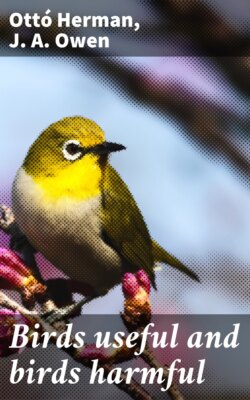Читать книгу Birds useful and birds harmful - J. A. Owen - Страница 10
На сайте Литреса книга снята с продажи.
The Long-eared Owl.
(Asio ótus.)
ОглавлениеTable of Contents
In the wooded districts of Great Britain this handsome Owl is always to be found; the numbers bred here are augmented also by a considerable number which come to us in autumn from the Continent. It is a larger bird than the Short-eared species and it lives much in the same way as the Brown Owl. These two are not so fastidious in their way of feeding as the White Owl. It lives on small birds, rodents, bats, fish, reptiles and large insects. Some have accused it of taking birds up to the size of a Plover, but the late Lord Lilford stated that he had never heard any complaint of its destruction of game in those districts where it was comparatively common; the castings of this species which he examined were mainly composed of the remains of greenfinches, sparrows and field mice. It is often seen flying about by daylight and it has been known to pick up and carry off wounded birds. It is said to be much disliked by other birds—possibly the last mentioned habit may be at the bottom of this strong feeling on their part, also its appropriation of other birds’ nests. The note of the hungry young birds of this species is a loud mewing.
The prophet Isaiah had not very pleasant associations with Owls, it would seem. When speaking of desolated places, he says, “Owls shall dwell there, and satyrs shall dance there ... the screech owl also shall rest there ... the great owl make her nest....”
Alluding to the death of Julius Cæsar—or rather to the omens that preceded it—Shakespeare wrote:
“And yesterday the bird of night did sit
Even at noonday, in the market-place,
Hooting and shrieking.”
Of crook-backed Richard of Gloucester, too, he says:
“The Owl shrieked at thy birth, an evil sign,
The night-crow cried.”
Different parts of the White Owl’s body were supposed to possess different magical powers, and they have been used by many a rural imposter to breed awe in the credulous.
Happily all this is changed now excepting amongst a small ignorant minority. Of late years women who affected the fashion of wearing owls heads and wings on toques seemed likely to become the poor Owls’ worst enemy. Mr. Ward Fowler saw, not long ago, in a public house, this advertisement: “Wanted at once by a London firm, 1,000 owls.”
The late R. Bosworth Smith wrote: “The number of owls has been terribly diminished. Let them be encouraged and protected in every possible way. Let the gamekeeper be rewarded, as I have rewarded him myself, not for the owls he destroys, but for the owls he preserves.... Let the owl be regarded and protected in England as the stork is regarded and protected in Holland!”
The Long-eared Owl is 15 inches in length. The upper parts are a warm buff, mottled and pearled with brown and grey and streaked with dark brown, bill black, dark markings about the eyes, facial disk buff with greyish black margin and outer rim. The long erectile tufts are streaked with dark brown. The eyes are a rich yellow. Under parts warm buff and grey with broad blackish streaks and small transverse bars. Legs covered to the toes with fawn coloured feathers. The eggs, four to six in number, are laid with us in an old squirrel’s drey or on the old nest of a Ringdove, a Magpie, Rook, Crow, or Heron’s nest; in Hungary often in that of a Buzzard or a Kite, with a few slight sticks and rabbits’ fur added. They are white, the surface smooth but not glossy. As a rule this species does not hoot like the Tawny Owl, but is rather silent.
USEFUL.
THE SHORT-EARED OWL.
